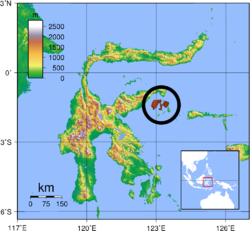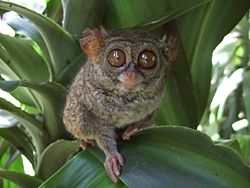Top Qs
Timeline
Chat
Perspective
List of tarsiiformes
Species in mammal infraorder Tarsiiformes From Wikipedia, the free encyclopedia
Remove ads
Tarsiiformes is an infraorder of small primates. It contains a single extant family, Tarsiidae, and members of this infraorder are called tarsiiformes, with members of the family named tarsiers. Tarsiiformes is one of the six major groups in the order Primates. They are found in Maritime Southeast Asia, primarily in forests, though some species can also be found in caves or wetlands. They range in size from the pygmy tarsier, at 8 cm (3 in) plus a 20 cm (8 in) tail, to the Philippine tarsier, at 16 cm (6 in) plus a 25 cm (10 in) tail. Tarsiers are carnivorous and primarily eat insects, though they also consume small vertebrates such as lizards, birds, or bats. The only tarsier with a population estimate is Niemitz's tarsier, estimated at 10,000 to 20,000 mature individuals, but it, along with the Peleng tarsier, pygmy tarsier, and Sangihe tarsier, is categorized as endangered species, while the Siau Island tarsier is classified as critically endangered.

The fourteen extant species of Tarsiiformes are divided into three genera: Carlito and Cephalopachus, each with a single species, and Tarsius, containing the other twelve. A few extinct prehistoric Tarsiiformes species have been discovered, though due to ongoing research and discoveries the exact number and categorization is not fixed.[1]
Remove ads
Conventions
The author citation for the species or genus is given after the scientific name; parentheses around the author citation indicate that this was not the original taxonomic placement. Conservation status codes listed follow the International Union for Conservation of Nature (IUCN) Red List of Threatened Species. Range maps are provided wherever possible; if a range map is not available, a description of the tarsier's range is provided. Ranges are based on the IUCN Red List for that species unless otherwise noted.
Remove ads
Classification
The infraorder Tarsiiformes consists of one extant family: Tarsiidae, containing fourteen species divided between three genera. Carlito and Cephalopachus each have a single species, and Tarsius contains the other twelve.
Family Tarsiidae
- Genus Carlito (Philippine tarsier): one species
- Genus Cephalopachus (Horsfield's tarsier): one species
- Genus Tarsius (tarsiers): twelve species
Tarsiiformes
Summarize
Perspective
The following classification is based on the taxonomy described by the reference work Mammal Species of the World (2005), with augmentation by generally accepted proposals made since using molecular phylogenetic analysis, as supported by both the IUCN and the American Society of Mammalogists.[2]
Family Tarsiidae
Remove ads
References
Sources
Wikiwand - on
Seamless Wikipedia browsing. On steroids.
Remove ads
















